Changes in Reconstructed Soil Physicochemical Properties in an Opencast Mine Dump in the Loess Plateau Area of China
Abstract
1. Introduction
2. Materials and Methods
2.1. Study Area
2.2. Sample Data
2.3. Sampling and Testing
2.4. Excluding Outliers
2.5. Research Content
3. Results
3.1. Horizontal Differences in Soil Physicochemical Properties
3.2. Vertical Differences of Soil Physicochemical Properties
3.3. Differences in Soil Physicochemical Properties under Different Vegetation Cover Types
4. Discussion
4.1. Analysis of Changes in Reconstructed Soil Physicochemical Properties
4.2. Guiding Significance for Reclamation Management of Mining Areas
5. Conclusions
Author Contributions
Funding
Acknowledgments
Conflicts of Interest
References
- BP p.l.c. BP Statistical Review of World Energy 2020; BP p.l.c.: London, UK, 2020. [Google Scholar]
- Tian, H.; Cai, Q.; Zhen, X. Development Prospects of Surface Coal Mining Industry in China. Coal Eng. 2014, 46, 11–14. [Google Scholar]
- Bian, Z. Research on land reclamation in coal mine area at China and abroad. China Land Sci. 2000, 14, 6–11. [Google Scholar] [CrossRef]
- Schladweiler, B.K. 40 years of the Surface Mining Control and Reclamation Act (SMCRA): What have we learned in the State of Wyoming. Int. J. Coal Sci. Technol. 2018, 5, 3–7. [Google Scholar] [CrossRef][Green Version]
- Jin, D.; Bian, Z. Polices, Laws and Regulations on Land Reclamation and the Implications: Comparing China with Other Countries. China Land Sci. 2009, 23, 66–73. [Google Scholar]
- Li, H.; She, C.; Zhou, Y.; Huang, Y. Summary and prospect of open-pit coal mining technology in China. China Land Sci. 2019, 47, 24–35. [Google Scholar]
- Qin, Q.; Wang, J.; Bai, Z.; Guo, L.; Wang, H. Three-dimensional reconstruction and quantitative characterization of reconstruction soil pore at opencast coal mine dump based on CT scanning. J. China Coal Soc. 2016, 41, 109–117. [Google Scholar] [CrossRef]
- Zhang, Y.; Wang, J.; Zhu, Y. Effects of land subsidence caused by coal mining on the spatial variation of soil total nitrogen and organic matter concentrations in loess area. Chin. J. Ecol. 2018, 37, 1676–1684. [Google Scholar]
- Liu, Q.; Zhang, Z.; Zhang, B.; Mu, W.; Zhang, H.; Li, Y.; Xu, N. Hydrochemical analysis and identification of open-pit mine water sources: A case study from the Dagushan iron mine in Northeast China. Sci. Rep. 2021, 11, 23152. [Google Scholar] [CrossRef] [PubMed]
- Pepliński, B.; Czubak, W. The influence of opencast lignite mining dehydration on plant production—a methodological study. Energies 2021, 14, 1917. [Google Scholar] [CrossRef]
- Haigh, M.J.; Gentcheva-Kostadinova, S. Ecological erosion control on coal-spoil banks: An evaluation. Ecol. Eng. 2002, 18, 371–377. [Google Scholar] [CrossRef]
- Wang, H.; Wang, J.; Cao, Y.; Lu, Y.; Qin, Q.; Wang, Y. Effect of soil and topography on vegetation restoration in an opencast coal mine dump in a loess area. Acta Ecol. Sin. 2016, 36, 5098–5108. [Google Scholar]
- Feng, Y.; Wang, J.; Bai, Z.; Reading, L. Effects of surface coal mining and land reclamation on soil properties: A review. Earth-Sci. Rev. 2019, 191, 12–25. [Google Scholar] [CrossRef]
- Munkholm, L.J.; Schjonning, P.; Kay, B.D. Tensile strength of soil cores in relation to aggregate strength, soil fragmentation and pore characteristics. Soil Tillage Res. 2002, 64, 125–135. [Google Scholar] [CrossRef]
- Nawaz, M.F.; Bourrie, G.; Trolard, F. Soil compaction impact and modelling. A review. Agron. Sustain. 2013, 33, 291–309. [Google Scholar] [CrossRef]
- Qin, Q.; Wang, H.; Li, X. Effect of Cutting on Forest Soil Function. World For. Res. 2018, 31, 13–17. [Google Scholar]
- Wu, Y.; Li, B. Soil Science; China Agriculture Press: Beijing, China, 2006. [Google Scholar]
- Liu, Q. The Coupling Relationship of Vegetation Patterns and Soil Properties in Typical Reach of The Middle and Lower Reaches of The Yellow River. Master’s Thesis, Henan University, Kaifeng, China, 2016. [Google Scholar]
- Zhao, Y.; Liu, H.; Wang, X.; Zou, Y.; Tian, S. Research on relationship between terrain factors and soil physical properties of reclamation dump based upon UAV image. China Coal 2018, 44, 117–122. [Google Scholar] [CrossRef]
- Zhao, L. Study on Land Reclamation Mode in Shuozhou Mining Area. Master’s Thesis, Shanxi Agricultural University, Jinzhong, China, 2013. [Google Scholar]
- Sonn, Y.K.; Hur, S.O.; Hyun, B.G.; Cho, H.J.; Shin, K.S. Differences in Spatial Variation of Soil Chemistry Between Natural and Anthropogenic Soils. Korean J. Soil Sci. Fertil. 2014, 47, 418–424. [Google Scholar] [CrossRef][Green Version]
- Jing, M. Evolution, Water and Soil Response and Optimization of Landform Construction in Giant Open-pit Coal Mine on Loess Area. Ph.D. Thesis, China University of Geosciences (Beijing), Beijing, China, 2014. [Google Scholar]
- Cao, Y.; Wang, J.; Bai, Z.; Zhou, W.; Zhao, Z.; Ding, X.; Li, Y. Differentiation and mechanisms on physical properties of reconstructed soils on open-cast mine dump of loess area. Environ. Earth Sci. 2015, 74, 6367–6380. [Google Scholar] [CrossRef]
- Min, X.; Li, X.; Li, Q. Influence of mechanical compaction on reclaimed soil particle size distribution multifractal characteristics. Trans. Chin. Soc. Agric. Eng. 2017, 33, 274–283. [Google Scholar]
- Wang, S.; Cao, Y.; Bai, Z.; Luo, G.; Kuang, X.; Yang, G. Spatial Characteristics of Reconstructed Soil Texture in Dumping Site of Loess Open-pit Mining Area. J. Northwest. For. Univ. 2020, 35, 40–51. [Google Scholar]
- Liu, X.; Bai, Z.; Zhou, W.; Cao, Y.; Zhang, G. Changes in soil properties in the soil profile after mining and reclamation in an opencast coal mine on the Loess Plateau, China. Ecol. Eng. 2017, 98, 228–239. [Google Scholar] [CrossRef]
- Zhang, J.R.; Wang, J.M.; Qin, Q.; Bai, Z. Three-dimensional Multi-fractal Characteristics of Reconstruction Soil Pore at Opencast Coal Mine Dump based on CT Scanning. Chin. J. Soil Sci. 2017, 48, 786–793. [Google Scholar] [CrossRef]
- Yu, D.; Jia, X.; Huang, L.; Shao, M.; Wang, J. Spatial Variation of Soil Bulk Density in Different Soil Layers in the Loess Area and Simulation. Acta Pedol. Sin. 2019, 56, 55–64. [Google Scholar]
- Zhang, G.; Bai, Z.; Zhang, C.; Zhang, J. Study on the Changes of Physic-chemical Properties of the Topsoil in Typical Plots in Pingshuo Mining Area. Hubei Agric. Sci. 2015, 54, 4168–4172. [Google Scholar] [CrossRef]
- Schroeder, P.D.; Daniels, W.L.; Alley, M.M. Chemical and Physical Properties of Reconstructed Mineral Sand Mine Soils in Southeastern Virginia. Soil Sci. 2010, 175, 2–9. [Google Scholar] [CrossRef]
- Luo, G.; Cap, Y.; Bai, Z.; Kuang, X.; Wang, S.; Song, L. Representation and Inversion of Reconstructed Soil Volumetric Water Content in Loess Open Pit Mining Area. J. Ecol. Rural. Environ. 2019, 35, 529–537. [Google Scholar]
- Liu, W.; Wag, J.; Bai, Z.; Zhang, G. Soil Organic Carbon Dynamics of Reclaimed Soils at an Opencast Coal Mine. Met. Mine 2014, 453, 141–146. [Google Scholar]
- Huang, Y.; Kuang, X.; Cao, Y.; Bai, Z. The soil chemical properties of reclaimed land in an arid grassland dump in an opencast mining area in China. RSC Adv. 2018, 8, 41499–41508. [Google Scholar] [CrossRef]
- Jobbágy, E.G.; Jackson, R.B. The vertical distribution of soil organic carbon and its relation to climate and vegetation. Ecol. Appl. 2000, 10, 423–436. [Google Scholar] [CrossRef]
- Kumar, S.; Singh, A.K.; Ghosh, P. Distribution of soil organic carbon and glomalin related soil protein in reclaimed coal mineland chrono sequence under tropical condition. Sci. Total Environ. 2018, 625, 1341–1350. [Google Scholar] [CrossRef]
- Li, Y.; Cao, Y.; Wang, S.; Luo, G.; Wang, J.; Zhou, W.; Bai, Z. Changes of Typical Physical Properties of Reclaimed Mine Soil in the Dump Site of Loess Open Mining Area. Ecol. Environ. Sci. 2020, 29, 615–623. [Google Scholar]
- Yao, X.; Niu, Y.; Dang, Z.; Qin, M.; Wang, K.; Zhou, Z.; Zhang, Q.; Li, J. Effects of natural vegetation restoration on soil quality on the Loess Plateau. J. Earth Environ. 2015, 6, 238–247. [Google Scholar] [CrossRef]
- Wang, Y.; Zhao, Z.; Yuan, Y.; Guo, A.; Cao, X.; Li, X. Evaluation of soil quality under three robinia pseudoacacia reclamation modes in Antaibao Opencast Mine. China Coal 2017, 43, 130–136. [Google Scholar] [CrossRef]
- Hu, F.; Du, H.; Zeng, F.; Song, T.; Peng, W.; Zhang, F. Dynamics of soil nutrient content and microbial diversity following vegetation restoration in a typical karst peak-cluster depression landscape. Acta Ecol. Sin. 2018, 38, 2170–2179. [Google Scholar]
- Mukhopadhyay, S.; Maiti, S.K.; Masto, R.E. Use of Reclaimed Mine Soil Index (RMSI) for screening of tree species for reclamation of coal mine degraded land. Ecol. Eng. 2013, 57, 133–142. [Google Scholar] [CrossRef]
- Mukhopadhyay, S.; Masto, R.E.; Yadav, A.; George, J.; Ram, L.C.; Shukla, S.P. Soil quality index for evaluation of reclaimed coal mine spoil. Sci. Total Environ. 2016, 542, 540–550. [Google Scholar] [CrossRef]
- Yang, Y.; Ouyang, Y.; Chen, H.; Xiao, K.; Li, D. Effects of Vegetation Restoration on Soil Nitrogen Pathways in a Karst Region of Southwest China. Environ. Sci. 2018, 39, 2845–2852. [Google Scholar] [CrossRef]
- Zhang, Y. Population Dynamics of Robinia pseudoacacia in Different Plant Configuration in Antaibao Opencast Coal Mine Dump. Master’s Thesis, Shanxi University, Taiyuan, China, 2014. [Google Scholar]
- Gu, Y. Spatial variability and response relationship of vegetation restoration and soil water fertilizer in an opencast coal−mine dump in a loess area. Master’s Thesis, China University of Geosciences (Beijing), Beijing, China, 2017. [Google Scholar]
- Wu, J. Effects of landscape design on the construction of ecological agriculture demonstration garden. Chin. J. Agric. Resour. Reg. Plan. 2017, 38, 148–153. [Google Scholar]
- Sun, C.; Cheng, Y.; Wang, X.; Jiao, L. Effects of vegetation restoration on soil physicochemical properties and heavy metal pollution characteristics in dump of open pit iron mine. Mod. Min. 2017, 33, 218–220, 224. [Google Scholar]
- Chen, J.; Yang, N. Soil Quality Assessment Along Re-vegetation on Sloping-Land with Purple Soils in Hengyang of Hunan Province, South-central China. Acta Agrestia Sin. 2018, 26, 160–167. [Google Scholar]
- Cao, Y.; Bai, Z.; Zhang, G.; Zhou, W.; Wang, J.; Yu, Q.; Du, Z. Soil Quality of Surface Reclaimed Farmland in Large Open-cast Mining Area of Shanxi Province. J. Agro-Environ. Sci. 2013, 23, 2422–2428. [Google Scholar]
- Bai, Z.; Yun, W. A case study on pingsshuo mining area: Land rehabilitation and reutilization in mining districts. Resour. Ind. 2008, 10, 32–37. [Google Scholar]
- Zhang, H. Experience of Improving Surrounding Ecological Environment in Antaibao Open-pitCoal Mine. Opencast Coal Min. Technol. 2002, 3–5. [Google Scholar] [CrossRef]
- Li, S. Land-use Change and Analysis of Land Reclamation Technology of An Taibao Opencast Mine. Master’s Thesis, Beijing Forestry University, Beijing, China, 2012. [Google Scholar]
- Wang, S.; Cao, Y.; Luo, G.; Kuang, X.; Song, L.; Bai, Z. Effects of reconstructing soil in open cast mining areas of the Loess Plateau on soil physical properties and vegetative growth. J. Agric. Resour. Environ. 2019, 36, 344–354. [Google Scholar]
- Luo, G.; Cao, Y.; Bai, Z.; Huang, Y.; Wang, S. Soil bulk density difference, ground penetrating radar feature identification, and simulation for a reclaimed soil profile in the dumping site of an open pit mine. J. Agric. Resour. Environ. 2019, 36, 441–452. [Google Scholar] [CrossRef]
- Liu, M.; Han, G.; Li, X. Comparative analysis of soil nutrients under different land-use types in the Mun River basin of Northeast Thailand. J. Soils Sediments 2021, 21, 1136–1150. [Google Scholar] [CrossRef]
- Xiao, B.; Wang, Q.; Li, C.; Cao, Z. Effects of reclamation of rehabilitated cropland on soil properties and its spatial variation on the Loess Plateau of China. J. Northwest. A F Univ. (Nat. Sci. Ed.) 2011, 39, 185–192. [Google Scholar]
- Zheng, Y.; Zhang, Z.; Yao, D.; Chen, X. Study on Influence of Gangue on Reclaimed Soil Properties. J. Anhui Univ. Sci. Technol. (Nat. Sci.) 2013, 33, 7–11. [Google Scholar] [CrossRef]
- Zhang, Y.; Song, Z.; Kong, T.; Zhao, D.; Wang, L.; Wang, Y. Amelioration Effect of Coal Gangue on Physical and Chemical Properties of Saline-alkaline Soil. Ecol. Environ. Sci. 2021, 30, 195–204. [Google Scholar] [CrossRef]
- Tan, X.; Mu, X.; Gao, P.; Sun, W.; Zhao, G.; Gu, C. Effects of vegetation restoration on changes to soil physical properties on the loess plateau. China Environ. Sci. 2019, 39, 713–722. [Google Scholar]
- Zhao, S.; Zhao, Y.; Wu, J. Quantitative analysis of soil pores under natural vegetation successions on the Loess Plateau. Sci. Sin. (Terrae) 2010, 40, 223–231. [Google Scholar] [CrossRef]
- Li, X.; Tian, J.; Zhang, C. A study on effects of different types of forest on the loess plateau on physical properties of soil. Sci. Silvae Sin. 1992, 28, 98–106. [Google Scholar]
- Xing, H.; Zhang, J.; Bai, Z.; Duan, Y.; Shangguan, T.; Guo, D. Correlation Analysis on Plant Recovery and Soil Factors in Antaibao Opencast Coal Mine Dumps. Environ. Sci. Manag. 2015, 40, 82–85. [Google Scholar]
- Bradshaw, A. Restoration of mined lands—Using natural processes. Ecol. Eng. 1997, 8, 255–269. [Google Scholar] [CrossRef]
- Chen, X.; Hu, Z.; Zhang, X. Reclamation Soil Compaction Spatial Variation Law about Different Reclamation Technologies in Subsidence Area. J. Irrig. Drain. 2005, 24, 74–77. [Google Scholar]
- Pang, B.; Yu, Y. Analysis on Soil Microbial Community in Different Land Use Types on Reclamation of Coal Waste Pile. Chin. J. Soil Sci. 2017, 48, 359–364. [Google Scholar]
- Chang, Q.; An, S.; Liu, J.; Wang, B.; Wei, Y. Study on Benefits of Recovering Vegetation to Prevent Land Deterioration on Loess Plateau. J. Soil Water Conserv. 1999, 5, 6–9. [Google Scholar]
- Wang, J.; Guo, L.; Bai, Z.; Qin, Q.; Lu, C. Effects of land reclamation time on soil pore number and porosity based on computed tomography (CT) images in opencast coal mine dump. Trans. Chin. Soc. Agric. Eng. 2016, 32, 229–236. [Google Scholar]
- Gasch, C.; Huzurbazar, S.; Stahl, P. Measuring soil disturbance effects and assessing soil restoration success by examining distributions of soil properties. Appl. Soil Ecol. 2014, 76, 102–111. [Google Scholar] [CrossRef]
- Li, T.C.; Shao, M.A.; Jia, Y.H. Application of X-ray tomography to quantify macropore characteristics of loess soil under two perennial plants. Eur. J. Soil Sci. 2016, 67, 266–275. [Google Scholar] [CrossRef]
- Guo, L.; Wang, J.; Bai, Z.; Yang, R.; Cao, Y. Analysis of spatial variability of soil granules in early stage of reclamation at opencast coal mine dump in loess area. China Min. Mag. 2015, 52–59. [Google Scholar] [CrossRef]
- Fan, W.; Li, H.; Bai, Z. The Research of the Soil Fertility Changes in Loess Area Large Opencast Coal Mine’s Different Reclamation Models and Reclamation Years—Taking Pingshuo ATB Opencast Coal Mine as Example. J. Shanxi Agric. Univ. (Nat. Sci. Ed.) 2006, 26, 313–316. [Google Scholar] [CrossRef]
- Hou, J.; Ye, G.; Zhang, L. The Research Progress of Rhizosphere Soil of Forest Trees. Prot. For. Sci. Technol. 2006, 1, 30–33. [Google Scholar] [CrossRef]
- Chen, X.; Liu, H.; Jiang, S.; Wang, G. Effects of Reclamation Mode on Soil Aggregate Composition and Organic Carbon and Nitrogen Distribution in Mining Area. J. Shanxi Agric. Sci. 2020, 48, 768–773. [Google Scholar] [CrossRef]
- Chen, X.; Li, Z.; Liu, M.; Jiang, C. Effects of Different Fertilizations on Organic Carbon and Nitrogen Contents in Water-Stable Aggregates and Microbial Biomass Content in Paddy Soil of Subtropical China. Sci. Agric. Sin. 2013, 46, 950–960. [Google Scholar]
- Zhou, S.; Xiang, Y.; Xiao, Y.; Huang, C.; Tang, J.; Luo, C.; Han, B.; Liang, K. Response of culturable soil microorganisms to simulated nitrogen deposition in a natural evergreen broadleaf forest in the Rainy Area of Western China. Acta Ecol. Sin. 2017, 37, 1191–1198. [Google Scholar] [CrossRef]
- Schipper, L.A.; Sparling, G.P. Accumulation of soil organic C and change in C:N ratio after establishment of pastures on reverted scrubland in New Zealand. Biogeochemistry 2011, 104, 49–58. [Google Scholar] [CrossRef]
- National Soil Census Office. Soil Survey Technology in China; China Agriculture Press: Beijing, China, 1992. [Google Scholar]
- Wang, J.; Zhang, M.; Bai, Z.; Yang, R.; Guo, L. Multi-fractal characteristics of reconstructed soil particle in opencast coal mine dump in loess area. Trans. Chin. Soc. Agric. Eng. 2014, 30, 230–238. [Google Scholar]
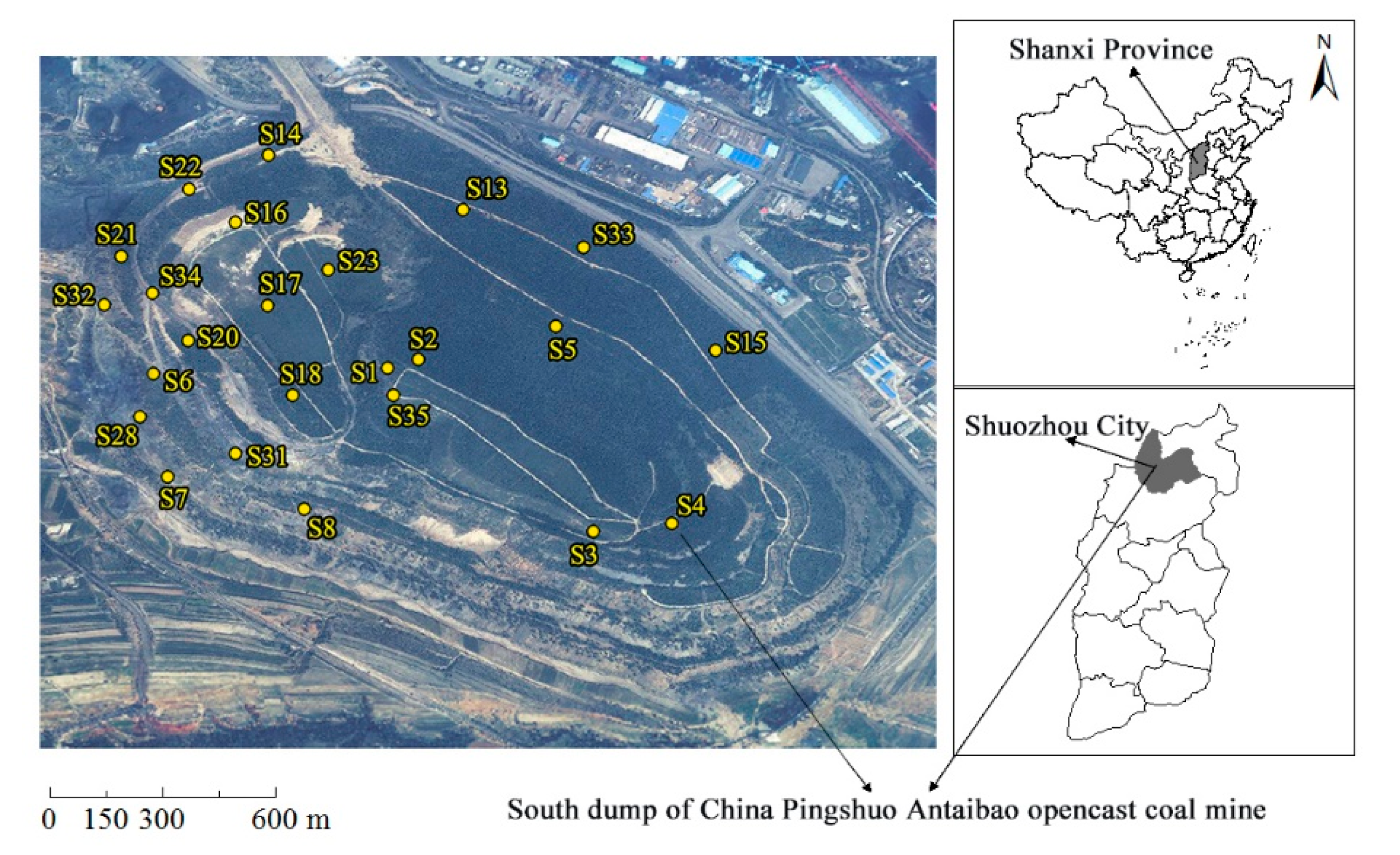
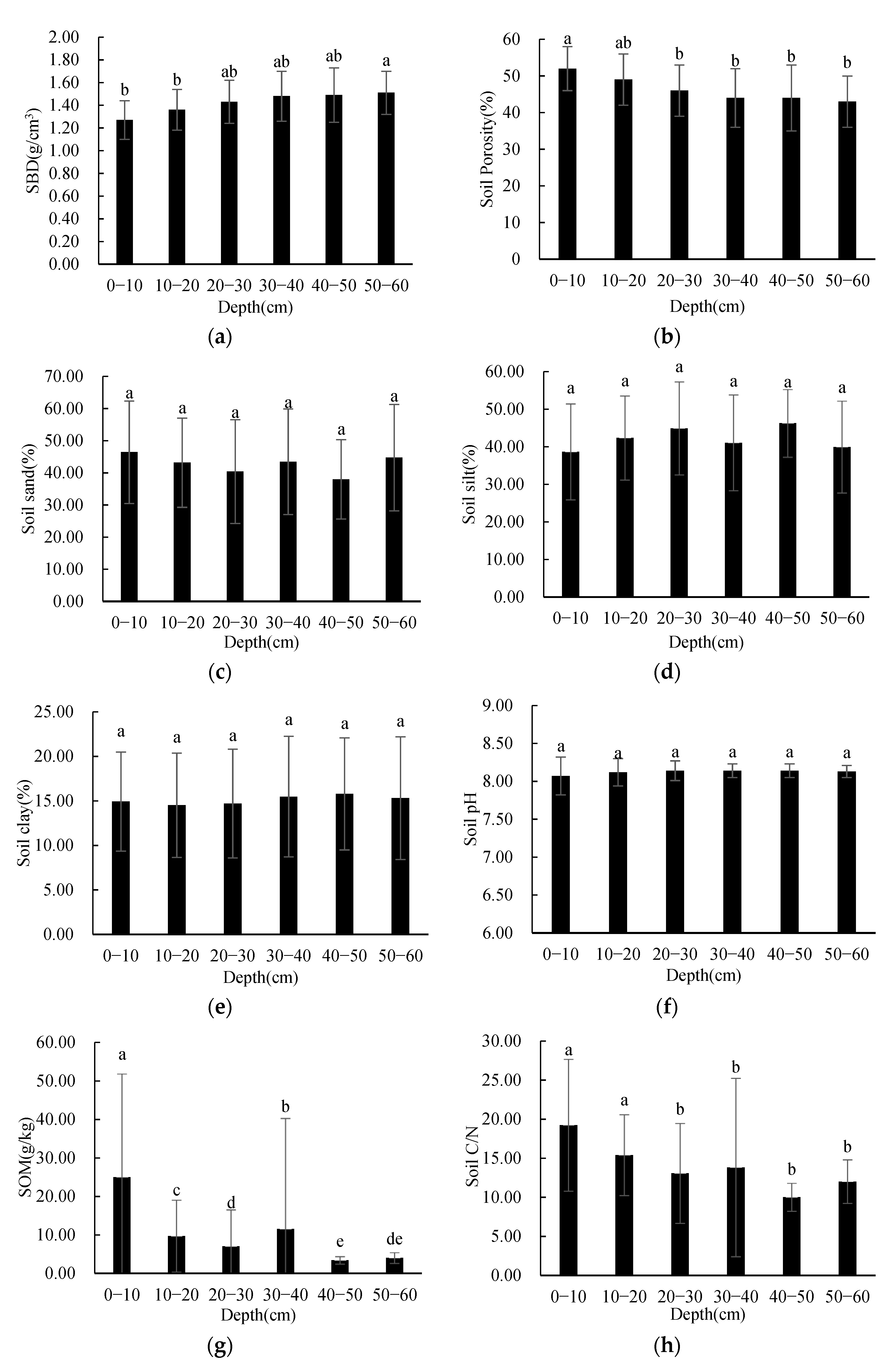
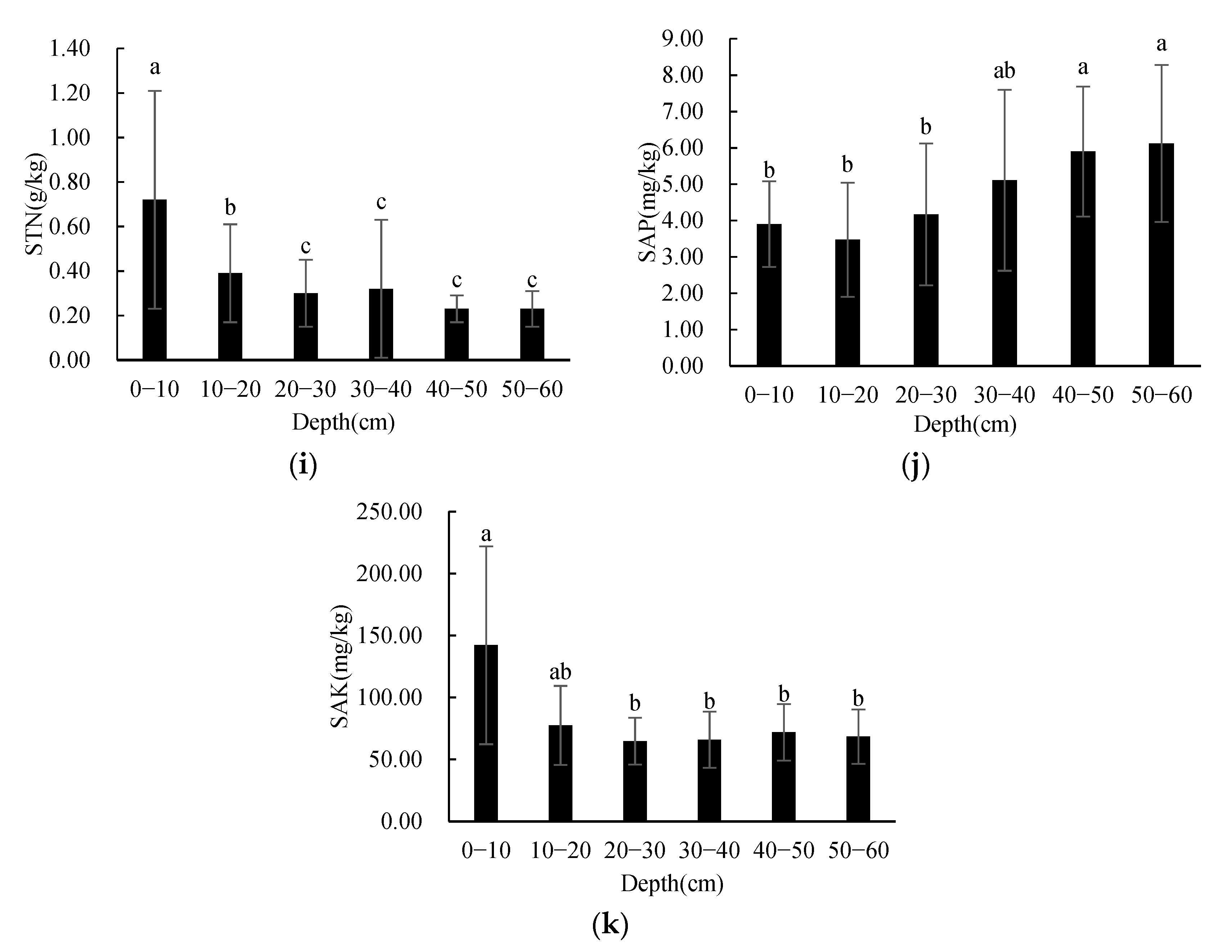



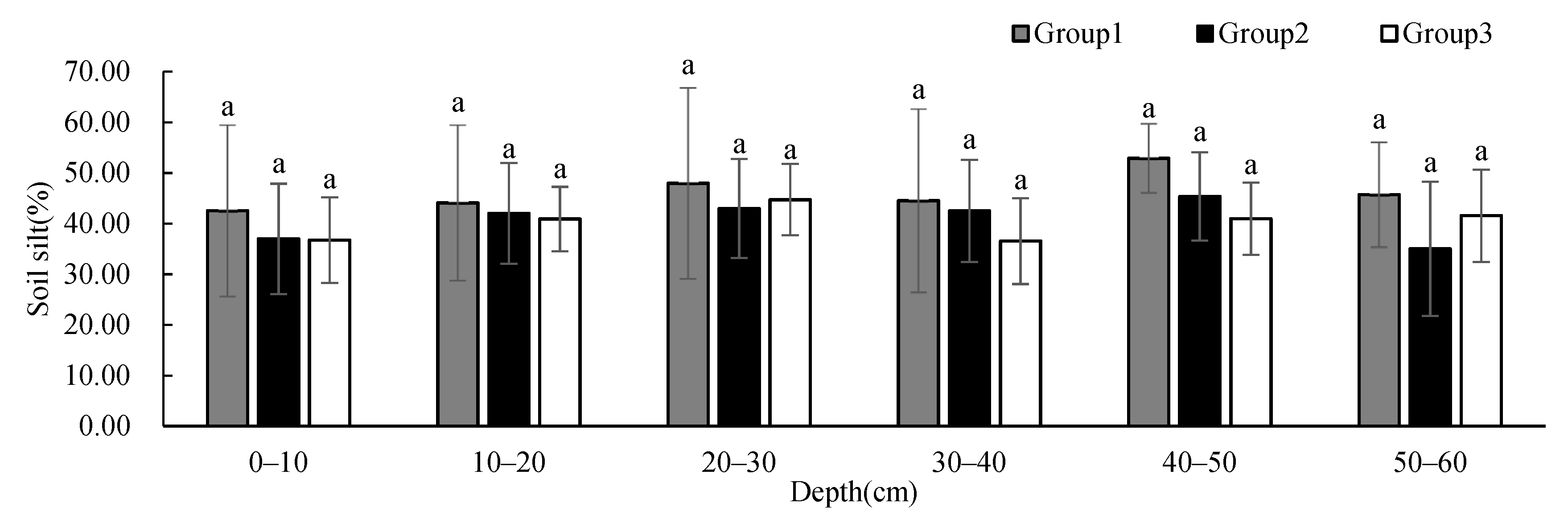
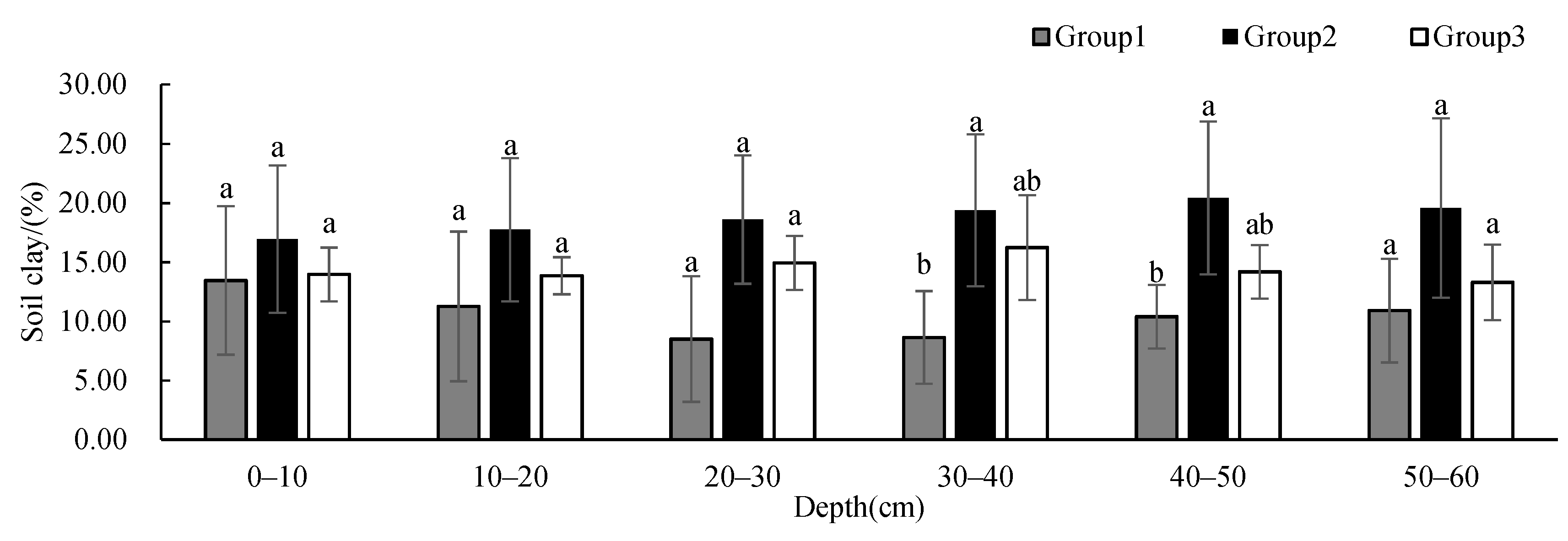


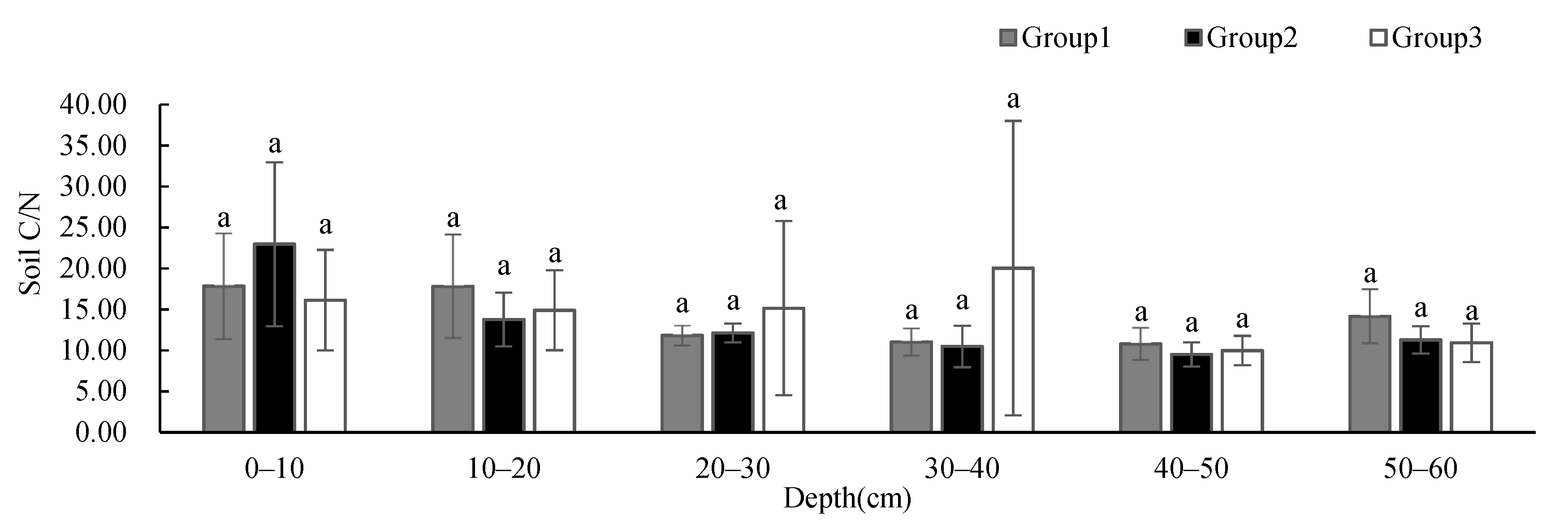


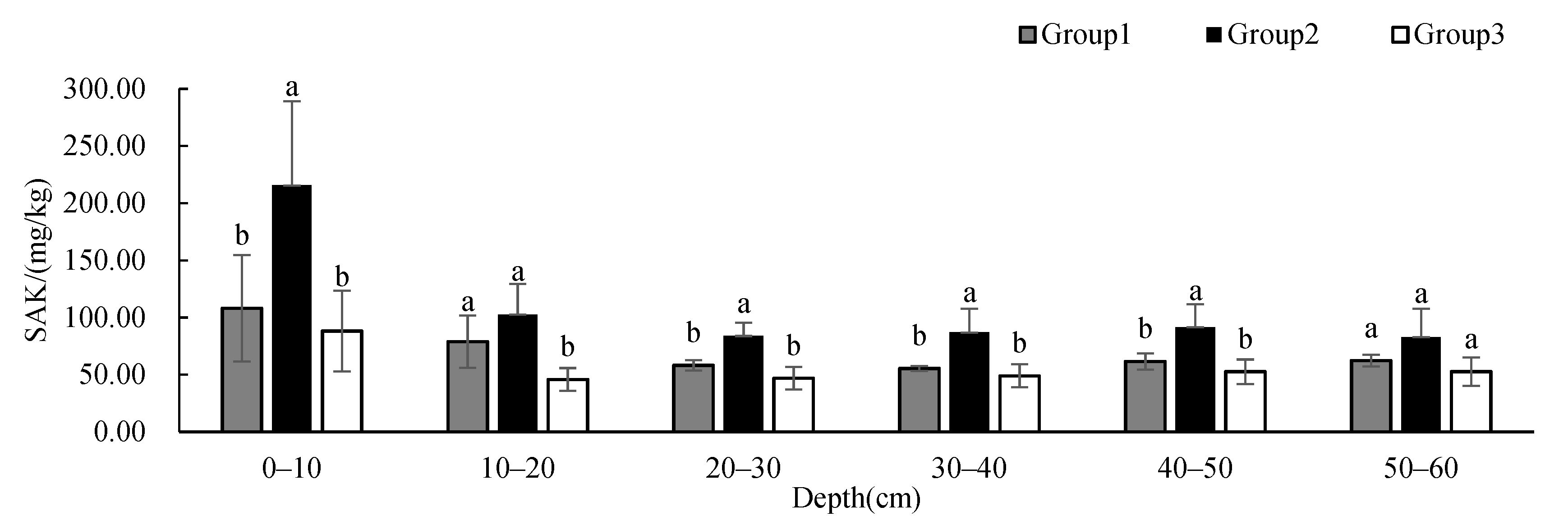
| Index | SBD g/cm3 | Soil Porosity % | Soil Sand % | Soil Silt % | Soil Clay % | pH | SOM g/kg | C/N | STN g/kg | SAP mg/kg | SAK mg/kg |
|---|---|---|---|---|---|---|---|---|---|---|---|
| Average | 1.42 | 46.42 | 42.77 | 42.13 | 15.10 | 8.12 | 10.41 | 14.06 | 0.37 | 4.73 | 82.63 |
| Standard deviation | 0.21 | 8.09 | 15.56 | 12.12 | 6.26 | 0.15 | 18.73 | 7.49 | 0.32 | 2.14 | 48.98 |
| Range | 1.10 | 41.48 | 68.11 | 57.66 | 29.62 | 0.96 | 116.81 | 49.17 | 1.62 | 8.62 | 285.71 |
| Maximum | 2.00 | 65.95 | 81.42 | 68.3 | 31.95 | 8.40 | 119.00 | 55.92 | 1.75 | 10.27 | 313.96 |
| Minimum | 0.90 | 24.46 | 13.31 | 10.64 | 2.33 | 7.44 | 2.19 | 6.76 | 0.13 | 1.65 | 28.25 |
| Median | 1.44 | 45.56 | 40.36 | 43.53 | 14.44 | 8.10 | 4.50 | 11.94 | 0.26 | 4.18 | 67.25 |
| Variation coefficient (%) | 15.10 | 17.43 | 36.37 | 28.77 | 41.46 | 1.88 | 179.94 | 53.31 | 85.54 | 45.24 | 59.28 |
| Depth cm | SBD % | Soil Porosity % | Soil Sand % | Soil Silt % | Soil Clay % | pH % | SOM % | C/N % | STN % | SAP % | SAK % |
|---|---|---|---|---|---|---|---|---|---|---|---|
| 0–10 | 13.02 | 12.07 | 34.35 | 33.05 | 37.23 | 3.04 | 107.24 | 43.90 | 68.24 | 30.26 | 56.19 |
| 10–20 | 13.06 | 13.80 | 32.19 | 26.43 | 40.36 | 2.20 | 96.53 | 33.67 | 57.06 | 45.29 | 41.15 |
| 20–30 | 13.20 | 15.42 | 39.95 | 27.58 | 41.59 | 1.56 | 135.60 | 48.97 | 50.24 | 46.77 | 29.11 |
| 30–40 | 14.90 | 18.77 | 37.83 | 31.08 | 43.77 | 1.12 | 249.65 | 82.68 | 94.89 | 48.74 | 34.30 |
| 40–50 | 15.98 | 20.55 | 32.57 | 19.50 | 39.83 | 1.09 | 28.12 | 18.02 | 27.50 | 30.39 | 31.72 |
| 50–60 | 12.59 | 16.71 | 37.01 | 30.66 | 44.98 | 0.95 | 35.38 | 23.19 | 35.29 | 35.29 | 32.23 |
| Group | Description | Specific Sample | Dominant Vegetation Species | Vegetation Coverage (%) | Quantity of Trees/Shrubs | Herb Biomass (g) |
| 1 | Trees—high canopy closure | S6, S8, S15, S20, S32 | Robinia pseudoacacia, Ulmus pumila, Pinus tabuliformis | 78.35 | 14.00 | 63.02 |
| 2 | Trees—low canopy closure | S1, S4, S5, S14, S18, S33 | Robinia pseudoacacia, Ulmus pumila | 62.50 | 5.63 | 199.38 |
| 3 | Shrubs | S3, S7, S17, S34, S35 | Caragana Korshinskii | 80.00 | 18.10 | 116.87 |
| Index | SBD g/cm3 | Soil Porosity % | Soil Sand % | Soil Silt % | Soil Clay % | pH | SOM g/kg | C/N | STN g/kg | SAP mg/kg | SAK mg/kg |
|---|---|---|---|---|---|---|---|---|---|---|---|
| Undamaged [48] | 1.30 | 50.94 | - | - | - | 8.11 | 9.68 | 13.10 | 0.50 | 6.32 | 90.60 |
| 3-Years-Reclamation [29,69,70] | 1.55 | 41.51 | 28.33 | 58.41 | 13.27 | 8.13 | 4.17 | 10.85 | 0.26 | 6.01 | 123.10 |
| Study area | 1.32 | 50.26 | 44.79 | 40.49 | 14.72 | 8.10 | 17.36 | 17.31 | 0.56 | 3.69 | 109.79 |
Publisher’s Note: MDPI stays neutral with regard to jurisdictional claims in published maps and institutional affiliations. |
© 2022 by the authors. Licensee MDPI, Basel, Switzerland. This article is an open access article distributed under the terms and conditions of the Creative Commons Attribution (CC BY) license (https://creativecommons.org/licenses/by/4.0/).
Share and Cite
Li, Y.; Zhou, W.; Jing, M.; Wang, S.; Huang, Y.; Geng, B.; Cao, Y. Changes in Reconstructed Soil Physicochemical Properties in an Opencast Mine Dump in the Loess Plateau Area of China. Int. J. Environ. Res. Public Health 2022, 19, 706. https://doi.org/10.3390/ijerph19020706
Li Y, Zhou W, Jing M, Wang S, Huang Y, Geng B, Cao Y. Changes in Reconstructed Soil Physicochemical Properties in an Opencast Mine Dump in the Loess Plateau Area of China. International Journal of Environmental Research and Public Health. 2022; 19(2):706. https://doi.org/10.3390/ijerph19020706
Chicago/Turabian StyleLi, Yuting, Wenxiang Zhou, Ming Jing, Shufei Wang, Yuhan Huang, Bingjin Geng, and Yingui Cao. 2022. "Changes in Reconstructed Soil Physicochemical Properties in an Opencast Mine Dump in the Loess Plateau Area of China" International Journal of Environmental Research and Public Health 19, no. 2: 706. https://doi.org/10.3390/ijerph19020706
APA StyleLi, Y., Zhou, W., Jing, M., Wang, S., Huang, Y., Geng, B., & Cao, Y. (2022). Changes in Reconstructed Soil Physicochemical Properties in an Opencast Mine Dump in the Loess Plateau Area of China. International Journal of Environmental Research and Public Health, 19(2), 706. https://doi.org/10.3390/ijerph19020706





